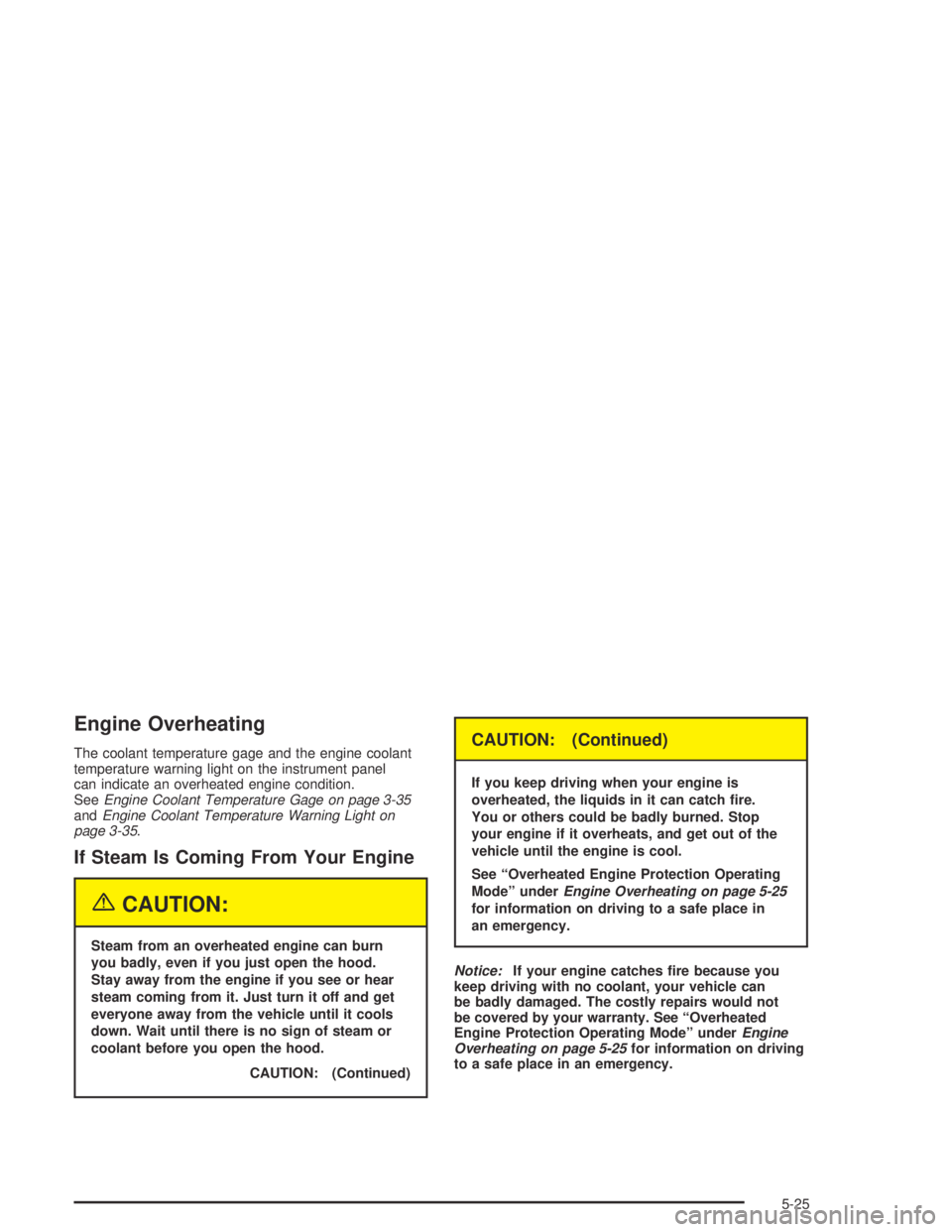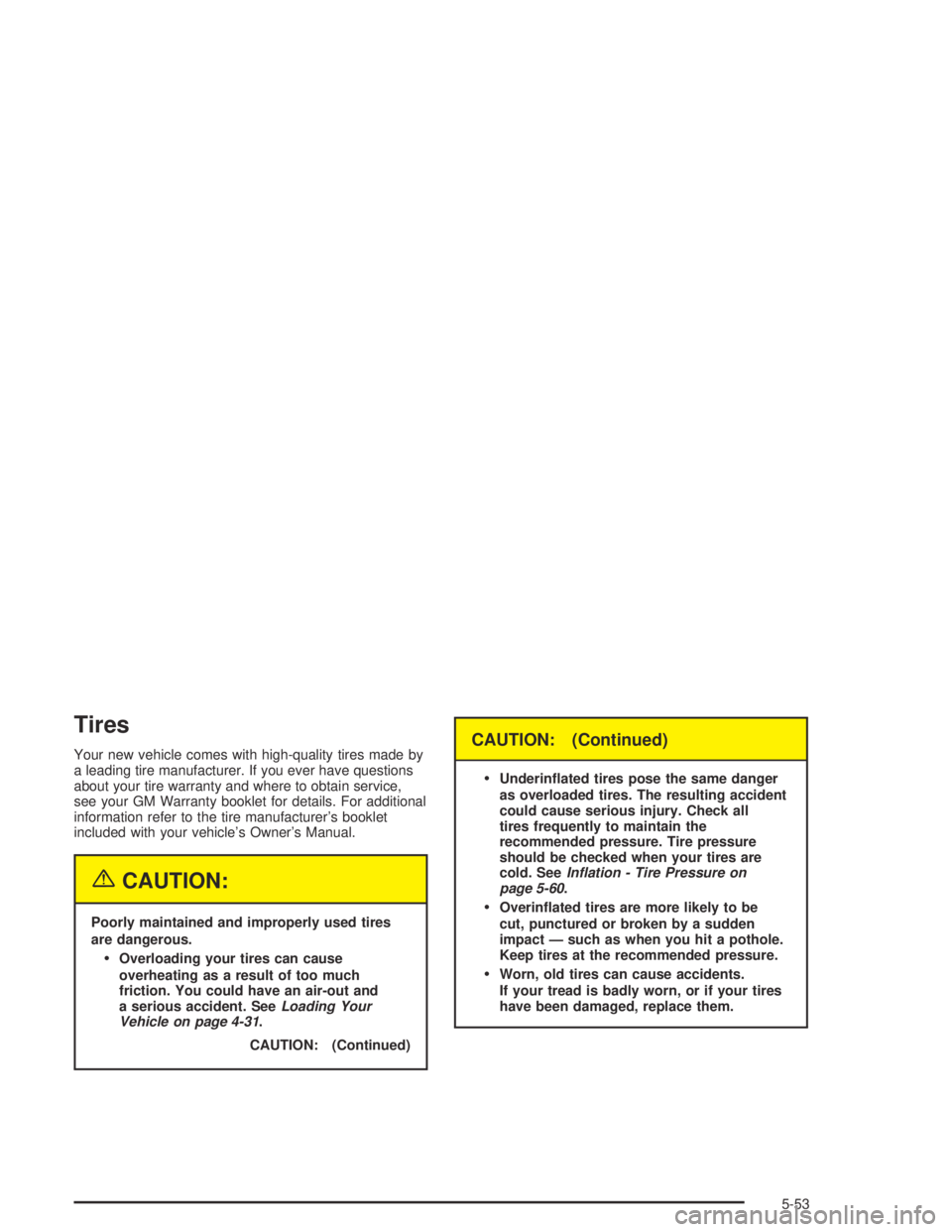2005 BUICK CENTURY heating
[x] Cancel search: heatingPage 234 of 348

Adding Coolant
If more coolant is needed, add the proper DEX-COOL®
coolant mixture at the coolant recovery tank, but be
careful not to spill it.
If the coolant recovery tank is completely empty, add
coolant to the radiator. See “How to Add Coolant to the
Radiator” later in this section.
{CAUTION:
Turning the radiator pressure cap when the
engine and radiator are hot can allow steam
and scalding liquids to blow out and burn you
badly. With the coolant recovery tank, you will
almost never have to add coolant at the
radiator. Never turn the radiator pressure
cap — even a little — when the engine and
radiator are hot.
{CAUTION:
You can be burned if you spill coolant on hot
engine parts. Coolant contains ethylene glycol,
and it will burn if the engine parts are hot
enough. Do not spill coolant on a hot engine.
Occasionally check the coolant level in the radiator.
For information on how to add coolant to the radiator,
seeCooling System on page 5-27.
Radiator Pressure Cap
Notice:The radiator cap on your vehicle is a
pressure-type cap and must be tightly installed to
prevent coolant loss and possible engine damage
from overheating. Be sure the arrows on the cap line
up with the over�ow tube on the radiator �ller neck.
The radiator pressure cap is located near the front of the
engine compartment on the passenger’s side of the
vehicle. SeeEngine Compartment Overview on
page 5-12for more information on location.
5-24
Page 235 of 348

Engine Overheating
The coolant temperature gage and the engine coolant
temperature warning light on the instrument panel
can indicate an overheated engine condition.
SeeEngine Coolant Temperature Gage on page 3-35
andEngine Coolant Temperature Warning Light on
page 3-35.
If Steam Is Coming From Your Engine
{CAUTION:
Steam from an overheated engine can burn
you badly, even if you just open the hood.
Stay away from the engine if you see or hear
steam coming from it. Just turn it off and get
everyone away from the vehicle until it cools
down. Wait until there is no sign of steam or
coolant before you open the hood.
CAUTION: (Continued)
CAUTION: (Continued)
If you keep driving when your engine is
overheated, the liquids in it can catch �re.
You or others could be badly burned. Stop
your engine if it overheats, and get out of the
vehicle until the engine is cool.
See “Overheated Engine Protection Operating
Mode” underEngine Overheating on page 5-25
for information on driving to a safe place in
an emergency.
Notice:If your engine catches �re because you
keep driving with no coolant, your vehicle can
be badly damaged. The costly repairs would not
be covered by your warranty. See “Overheated
Engine Protection Operating Mode” underEngine
Overheating on page 5-25for information on driving
to a safe place in an emergency.
5-25
Page 238 of 348

{CAUTION:
Heater and radiator hoses, and other engine
parts, can be very hot. Do not touch them.
If you do, you can be burned.
Do not run the engine if there is a leak. If you
run the engine, it could lose all coolant.
That could cause an engine �re, and you could
be burned. Get any leak �xed before you drive
the vehicle.
If there seems to be no leak, with the engine on, check
to see if the electric engine cooling fans are running.
If the engine is overheating, both fans should be
running. If they are not the vehicle needs service.Notice:Engine damage from running your engine
without coolant is not covered by your warranty.
See “Overheated Engine Protection Operating
Mode” in the Index for information on driving to a
safe place in an emergency.
Notice:Using coolant other than DEX-COOL®may
cause premature engine, heater core or radiator
corrosion. In addition, the engine coolant may
require changing sooner, at 30,000 miles (50 000 km)
or 24 months, whichever occurs �rst. Any repairs
would not be covered by your warranty. Always use
DEX-COOL
®(silicate-free) coolant in your vehicle.
5-28
Page 263 of 348

Tires
Your new vehicle comes with high-quality tires made by
a leading tire manufacturer. If you ever have questions
about your tire warranty and where to obtain service,
see your GM Warranty booklet for details. For additional
information refer to the tire manufacturer’s booklet
included with your vehicle’s Owner’s Manual.
{CAUTION:
Poorly maintained and improperly used tires
are dangerous.
Overloading your tires can cause
overheating as a result of too much
friction. You could have an air-out and
a serious accident. SeeLoading Your
Vehicle on page 4-31.
CAUTION: (Continued)
CAUTION: (Continued)
Underin�ated tires pose the same danger
as overloaded tires. The resulting accident
could cause serious injury. Check all
tires frequently to maintain the
recommended pressure. Tire pressure
should be checked when your tires are
cold. SeeInflation - Tire Pressure on
page 5-60.
Overin�ated tires are more likely to be
cut, punctured or broken by a sudden
impact — such as when you hit a pothole.
Keep tires at the recommended pressure.
Worn, old tires can cause accidents.
If your tread is badly worn, or if your tires
have been damaged, replace them.
5-53
Page 303 of 348

Fuses Usage
Blank Not Used
R/LAMPS Taillamps, License Plate Lamps
Blank Not Used
Blank Not Used
CRUISE Cruise Control
Blank Not Used
CLSTR Instrument Panel Cluster
LTR Cigarette Lighter
STOP LAMPS Stoplamps
ONSTAR OnStar
®
PRK/LGHT Parking Lamps
Blank Not Used
CRNK SIG,
BCM, CLSTRCrank Signal, Body Control Module,
Cluster, Powertrain Control Module
HVACIgnition Signal, Heating, Ventilation,
and Air Conditioning Control Head
BTSI (REGAL) Not Used
AIR BAG Air Bag
Fuses Usage
BCM PWR Body Control Module
HAZARD Hazard Warning Flashers
LH HTD SEAT Not Used
Blank Not Used
BCM ACCYIgnition Signal: Hot in ACCESSORY
and RUN, Body Control Module
Blank Not Used
LOW BLWR Low Blower
ABS Anti-Lock Brakes
TRN SIG Turn Signals, Cornering Lamps
RADIO, HVAC,
RFA, CLSTR
ALDLRadio, Heating Ventilation and
Air Conditioning Head; Remote
Keyless Entry, Cluster
HI BLWR High Blower
RH HTD SEAT Not Used
STR/WHL/
CNTRLAudio Steering Wheel Controls
WPR Windshield Wipers
5-93
Page 304 of 348

Underhood Fuse Block
Some fuses and relays are located in the underhood
fuse block on the passenger’s side of the vehicle in the
engine compartment. SeeEngine Compartment
Overview on page 5-12for more information on location.
Fuses Usage
1 Anti-Lock Brake System
2 Starter Solenoid
3 Power Seat, Rear Window Defogger
4High Blower, Hazard Flasher,
Stoplamps, Power Mirror,
Door Locks
Fuses Usage
5Ignition Switch, Stoplamps,
Anti-Lock Brake System, Turn
Signals, Cluster, Air Bag, Daytime
Running Lamps Module
6 Cooling Fan
7Retained Accessory Power,
Remote Keyless Entry, Data Link,
Heating, Ventilation, and Air
Conditioning Head; Cluster, Radio,
Cigarette Lighter
8Ignition Switch, Wipers, Audio
Steering Wheel Controls, Body
Control Module, Power Windows,
Sunroof, Heating, Ventilation, and
Air Conditioning Controls; Daytime
Running Lamps, Rear Window
Defogger Relay
Relays Usage
9 Cooling Fan 2
10 Cooling Fan 3
11 Starter Solenoid
12 Cooling Fan 1
13 Ignition Main
14 Air Pump (Optional)
5-94
Page 340 of 348

D
Daytime Running Lamps/Automatic
Headlamp System.......................................3-14
Defensive Driving............................................. 4-2
Delayed Entry Lighting.....................................3-16
Delayed Exit Lighting.......................................3-17
Delayed Headlamps........................................3-13
Doing Your Own Service Work........................... 5-4
Dome Lamp...................................................3-16
Door
Locks........................................................2-10
Power Door Locks.......................................2-11
Programmable Automatic Door Locks.............2-11
Trunk Ajar Warning Light..............................3-42
Driver
Position, Safety Belt.....................................1-12
Driving
At Night.....................................................4-16
City...........................................................4-20
Defensive..................................................... 4-2
Drunken....................................................... 4-3
Freeway.....................................................4-21
Hill and Mountain Roads..............................4-24
In Rain and on Wet Roads...........................4-17
Rocking Your Vehicle to Get it Out.................4-31
Winter........................................................4-26
Dual Automatic Climate Control System.............3-21
Dual Climate Control System............................3-18
E
Electrical System
Add-On Equipment......................................5-90
Fuses and Circuit Breakers...........................5-91
Headlamp Wiring.........................................5-91
Instrument Panel Fuse Block.........................5-91
Power Windows and Other Power Options......5-91
Underhood Fuse Block.................................5-94
Windshield Wiper Fuses...............................5-91
Engine
Air Cleaner/Filter.........................................5-18
Battery.......................................................5-39
Change Engine Oil Light...............................3-40
Check and Service Engine Soon Light............3-36
Coolant......................................................5-22
Coolant Heater............................................2-20
Coolant Temperature Gage...........................3-35
Coolant Temperature Warning Light................3-35
Drive Belt Routing.......................................6-15
Engine Compartment Overview......................5-12
Exhaust.....................................................2-27
Oil .............................................................5-13
Overheated Protection Operating Mode...........5-26
Overheating................................................5-25
Starting......................................................2-19
Enhanced Traction System (ETS)........................ 4-9
Warning Light.............................................3-34
Entry Lighting.................................................3-16
4